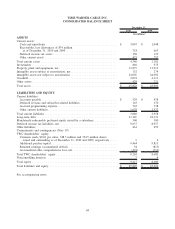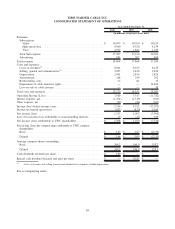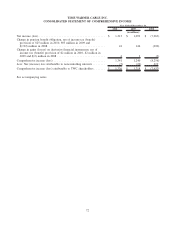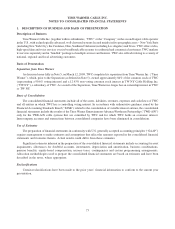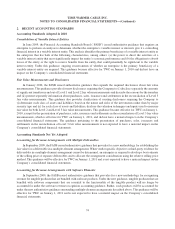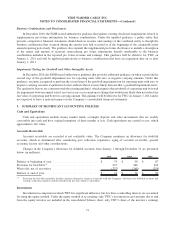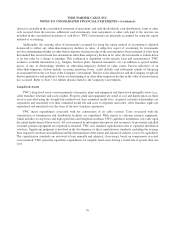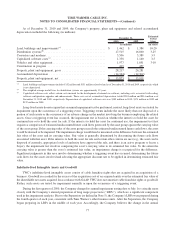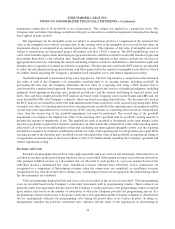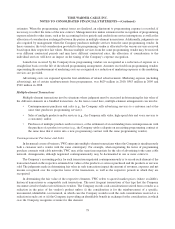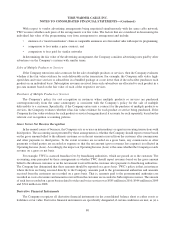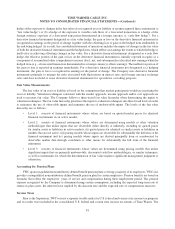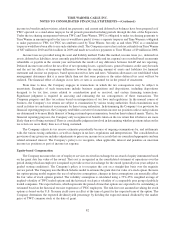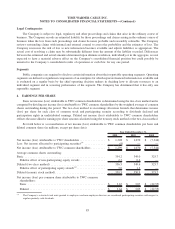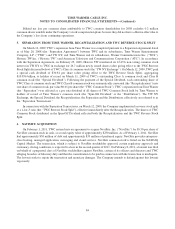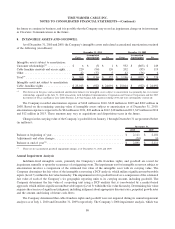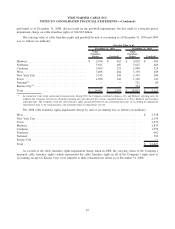Time Warner Cable 2010 Annual Report Download - page 90
Download and view the complete annual report
Please find page 90 of the 2010 Time Warner Cable annual report below. You can navigate through the pages in the report by either clicking on the pages listed below, or by using the keyword search tool below to find specific information within the annual report.impairment testing date to be preferable in its circumstances. This change was applied on a prospective basis. The
Company does not believe this change would have delayed, accelerated or avoided an impairment charge had the change
been applied in prior periods.
The impairment test for intangible assets not subject to amortization involves a comparison of the estimated fair
value of the intangible asset with its carrying value. If the carrying value of the intangible asset exceeds its fair value, an
impairment charge is recognized in an amount equal to that excess. The estimates of fair value of intangible assets not
subject to amortization are determined using a discounted cash flow (“DCF”) analysis. The DCF methodology used to
value cable franchise rights entails identifying the projected discrete cash flows related to such cable franchise rights and
discounting them back to the valuation date. Significant judgments inherent in this analysis include the selection of
appropriate discount rates, estimating the amount and timing of future cash flows attributable to cable franchise rights and
identification of appropriate terminal growth rate assumptions. The discount rates used in the DCF analyses are intended
to reflect the risk inherent in the projected future cash flows generated by the respective intangible assets. Refer to Note 8
for further details regarding the Company’s indefinite-lived intangible assets and related impairment testing.
Goodwill impairment is determined using a two-step process. The first step involves a comparison of the estimated
fair value of each of the Company’s six geographic reporting units to its carrying amount, including goodwill. In
performing the first step, the Company determines the fair value of a reporting unit using a DCF analysis that is
corroborated by a market-based approach. Determining fair value requires the exercise of significant judgment, including
judgment about appropriate discount rates, perpetual growth rates and the amount and timing of expected future cash
flows. The cash flows employed in the DCF analyses are based on the Company’s most recent budget and LRPs and, for
years beyond the LRPs, the Company’s estimates, which are based on assumed growth rates. The discount rates used in
the DCF analyses are intended to reflect the risks inherent in the future cash flows of the respective reporting units. If the
estimated fair value of a reporting unit exceeds its carrying amount, goodwill of the reporting unit is not impaired and the
second step of the impairment test is not necessary. If the carrying amount of a reporting unit exceeds its estimated fair
value, then the second step of the goodwill impairment test must be performed. The second step of the goodwill
impairment test compares the implied fair value of the reporting unit’s goodwill with its goodwill carrying amount to
measure the amount of impairment, if any. The implied fair value of goodwill is determined in the same manner as the
amount of goodwill recognized in a business combination. In other words, the estimated fair value of the reporting unit is
allocated to all of the assets and liabilities of that unit (including any unrecognized intangible assets) as if the reporting
unit had been acquired in a business combination and the fair value of the reporting unit was the purchase price paid. If the
carrying amount of the reporting unit’s goodwill exceeds the implied fair value of that goodwill, an impairment charge is
recognized in an amount equal to that excess. Refer to Note 8 for further details regarding the Company’s goodwill and
related impairment testing.
Revenues and Costs
Revenues are principally derived from video, high-speed data and voice services and advertising. Subscriber fees are
recorded as revenues in the period during which the service is provided. Subscription revenues received from subscribers
who purchase bundled services at a discounted rate are allocated to each product in a pro-rata manner based on the
individual product’s determined fair value. Installation revenues obtained from subscriber service connections are
recognized as a component of Subscription revenues when the connections are completed, as installation revenues
recognized are less than the related direct selling costs. Advertising revenues are recognized in the period during which
the advertisements are exhibited.
Video programming, high-speed data and voice costs are recorded as the services are provided. Video programming
costs are recorded based on the Company’s contractual agreements with its programming vendors. These contracts are
generally multi-year agreements that provide for the Company to make payments to the programming vendors at agreed
upon market rates based on the number of subscribers to which the Company provides the programming service. If a
programming contract expires prior to the parties’ entry into a new agreement and the Company continues to distribute the
service, management estimates the programming costs during the period there is no contract in place. In doing so,
management considers the previous contractual rates, inflation and the status of the negotiations in determining its
78
TIME WARNER CABLE INC.
NOTES TO CONSOLIDATED FINANCIAL STATEMENTS—(Continued)


